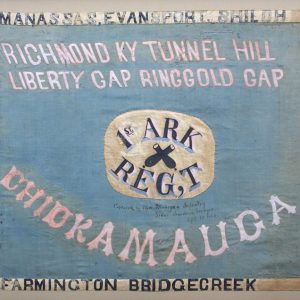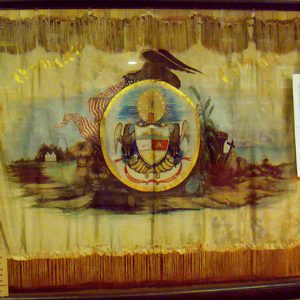calsfoundation@cals.org
Fifteenth (Josey's) Arkansas Infantry (CS)
The Fifteenth Arkansas Infantry Regiment was a Confederate unit that served in the Western Theater during the American Civil War. Not to be confused with the Fifteenth (Northwest) or Fifteenth (Johnson’s), it fought with the Army of Tennessee in all its major engagements until surrender at Greensboro, North Carolina, on April 26, 1865.
The regiment was organized on May 14, 1861, as the First Regiment Arkansas State Troops, consisting of companies from Phillips, Monroe, Jefferson, Desha, Mississippi, and Prairie counties. Its first commander was Colonel Patrick R. Cleburne, an Irish immigrant from Helena (Phillips County). On July 23, 1861, the regiment was enrolled in Confederate service as the First Arkansas Infantry at Pittman’s Ferry, Arkansas. Due to there being another unit designated as the First Arkansas (Fagan’s), it was re-designated as the Fifteenth Arkansas Infantry. Although two Fifteenths already existed, no additional changes were made.
The regiment crossed into Tennessee and Kentucky in early 1862 and withdrew along with other Confederate forces to Corinth, Mississippi, in the retreat that spring. Command of the regiment fell to Lieutenant Colonel Archibald Patton when Cleburne was promoted to brigadier general in March. The Fifteenth saw its first action of the war at the Battle of Shiloh on April 6–7, 1862. The regiment suffered heavily, losing many men, as well as all field officers.
Colonel Lucius E. Polk succeeded Patton and led the regiment during the 1862 August invasion of Kentucky. Temporarily consolidated with the Thirteenth Arkansas, it saw action at battle of Richmond, losing two killed and nineteen wounded. The regiment next fought the Battle of Murfreesboro, Tennessee, on December 31, 1862, suffering sixty-eight casualties. Colonel Polk was promoted to brigadier general the day before the battle, and John E. Josey took command.
After participation in the Tullahoma Campaign in central Tennessee, and the June 24, 1863, Battle of Liberty Gap, the regiment was consolidated with the Second and Twenty-Fourth Arkansas regiments. This combined unit of 295 men fought in the September 19–20, 1863, Battle of Chickamauga, Georgia, participating in the defeat of Union forces and later forcing them into Chattanooga. In November, Federal forces broke out of the city and attacked Confederates along Missionary Ridge, shattering their lines. The Fifteenth, as part of Cleburne’s Division, aided in saving the retreating Confederate army from total destruction at the battles of Tunnel Hill (November 25), and Ringgold Gap (November 27) in Georgia.
In the spring of 1864, Federal forces under General William T. Sherman advanced to take the vital railway hub of Atlanta, Georgia. Now part of Brigadier General Daniel Govan’s brigade, the Fifteenth was consolidated with the First Arkansas Infantry and, from May through June, experienced constant skirmishing and marching across northwestern Georgia. During that period, they fought the battles of Rocky Face Ridge, Resaca, New Hope Church, and Kennesaw Mountain. At Kennesaw Mountain, the Fifteenth was recognized for its human compassion when it stopped the battle in order to allow Union wounded to be rescued from wildfires raging in front of their position. After all men were removed from danger, the battle began again. A pair of pistols was presented the following day to the commander of the consolidated regiment for this act of kindness. In July, Lieutenant General John Bell Hood took command of the Army of Tennessee. In the game of fight and fall back, the regiment fought through the rest of the summer near Atlanta at the battles of Peach Tree Creek, Atlanta, and Jonesboro before retreating into northwestern Georgia after abandoning Atlanta on September 1, 1864.
Heavy losses in Govan’s Brigade resulted in the First and Fifteenth Arkansas’s consolidation with two other Arkansas units of the brigade into one regiment. Hood’s army moved north into Tennessee, fighting at Spring Hill before arriving in front of Franklin, where the Union army awaited attack. Hood launched a full frontal assault on November 30, 1864, that proved disastrous to the Army of Tennessee. Cleburne and five other generals were killed. The consolidated Arkansas regiment to which the Fifteenth belonged numbered only 300 men but lost close to 200 as casualties.
Union forces retreated during the night to Nashville, followed by the remnant of Hood’s army. The Battle of Nashville, fought on December 15–16, resulted in another defeat and retreat of the Confederate forces. The men of the Fifteenth fought their final battle at Bentonville, North Carolina, on March 19–21, the last major Confederate assault of the war. The survivors surrendered with the Army of Tennessee on April 26, 1865, at Greensboro, North Carolina.
For additional information:
Buck, Irving S. Cleburne and His Command. Jackson, TN: McCowat-Mercer Press, 1957.
Cutrer, Thomas W., ed. The Folly and the Madness: The Civil War Letters of Captain Orlando S. Palmer, Fifteenth Arkansas Infantry. Knoxville: University of Tennessee Press, 2023.
Purdue, Howell, and Elizabeth Purdue. Pat Cleburne, Confederate General. Hillsboro, TX: Junior College Press, 1973.
Anthony Rushing
Benton, Arkansas
 Civil War through Reconstruction, 1861 through 1874
Civil War through Reconstruction, 1861 through 1874 Military
Military 1st and 15th Infantry Regiment Flag
1st and 15th Infantry Regiment Flag  ACWSC Logo
ACWSC Logo  Phillips Guards Flag
Phillips Guards Flag 



Comments
No comments on this entry yet.